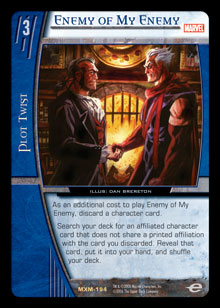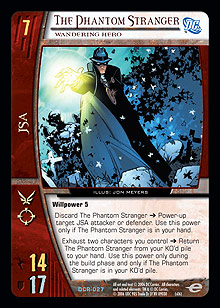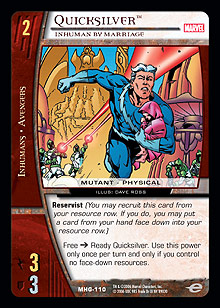Unless you’ve been living under a rock, I’m sure you all noticed that Marvel Team-Up is upon us. Many players got their greedy little hands on all kinds of wonderful cardboard goodness, and I was definitely one of them. This was actually my first Sneak Preview event since the X-Men expansion, so it was an especially fun time. (I missed all the Sneak Previews between The X-Men and Marvel Team-Up due to wedding and family obligations.)
As many of you have seen, Marvel Team-Up is outstanding and has a lot to offer competitive play. Because of this, you are probably just dying to know what I am going to talk about today. After much consideration, I decided to try to give you an analytical process for determining the power level of cards. I know that may seem rather silly and sound like a waste of time, but finding “lynchpin” cards to base a deck around can be a very difficult task. The easiest way to convey this process is to examine a few methods of searching for those powerful cards.
What Is a “Lynchpin” Card?

A “lynchpin” is a card or group of cards that inspires creative deckbuilding in a player or accomplishes a specific purpose within a deck. Many of the top-level tournament decks that you see on
Metagame.com revolve around a particular lynchpin card or card interaction. It’s not hard to see why these cards are the building blocks of a good decklist. Creativity in deckbuilding is a commodity that is largely sought after but rarely attained in the TCG world. The biggest hurdle we have to overcome in order to jumpstart those creative juices is actually the discovery of cards that can be used in new or unique ways. Sometimes these cards are easy to spot—for example,
Enemy of My Enemy—but other times, it takes a little more digging to discover those diamonds in the rough. While the process can be difficult at first, it is much easier to apply once it is put into practice. What follows is a discussion that could prove quite beneficial when trying to find those cards which make a deck run.
Let’s Start Simple!
Often when players attempt to construct the “next big thing” they will try to find a complex combination of cards and then build around it. Unfortunately, going about deck construction in this manner will just frustrate the building process. When you limit yourself to a particular card interaction from the get-go, you are also limiting your deck construction card pool. While I wouldn’t recommend this tactic, it has obviously paid off for some players, like Jason Hager. He was able to turn the concept of making an opponent discard his or her hand into a very powerful deck with Justice League of Arkham. Unless your initials happen to be J.H., however, I don’t consider this method to be an effective form of deck construction.
Instead of taking the “Hager” approach, I would urge you to familiarize yourself with the “Wiggy” school of thought. I may not be the master deckbuilder that Jason Hager is, but I know how to have fun while still being somewhat competitive. Normally, I don’t dip into the deck construction side of things when my team is preparing for a big event; however, for this Pro Circuit, I have been very active with Tim Batow in trying to develop a deck that can win big Down Under.
Generally, when I start working on a decklist, I take a concept and work up. When I say “concept,” I mean a deck type like burn, stall, aggressive, off-curve, curve, or combo (the last of which I leave to the experts like Batow or Hager). When you have a concept in place, it is much easier to determine which cards can make or break a deck.
It would be a moot point to list every possible card that can get you started on deck construction. There are just too many to consider. I would urge you to go with your gut and not to get fancy. Often, the obvious choice is the best one (or if it’s a multiple choice test, always circle “c”). Once you have a framework in place, it will become ten times easier to find those essential cards that make the deck “pop.”
Multiple Effects
Once you have a conceptual framework in place, you can start to see which cards will work well within your deck. This is where the real deck creativity and card selection begin. Specifically, there are some cards that work well within a particular conceptual deck but are not strong enough to base an entire deck around.
Take Genis-Vell ◊ Photon, for example. Ever since Genis-Vell was released, my team recognized that he had some untapped potential. Unfortunately, he is just not a character that inspires you to build a deck. At the time of the X-Men expansion release, my team was focusing on building a Squadron Supreme mid-curve deck for the upcoming PC. It was at Tim’s suggestion that we tried out Photon. The deck obviously operates best when its wielder has no cards in hand, and Genis-Vell ◊ Photon was a great discard outlet. Add in the fact that he gave the deck a late game threat and could be pulled out of the row, and we had found an absolute gem for our deck. I can honestly say that in at least three matches that come to memory, Photon made the difference between winning and losing. He was crucial to our team’s success at that PC.
As you can see, these are the types of cards that can turn a decent deck concept into a legitimate contender. Sadly, they are not always so easily discernable. I urge you to keep an eye out for cards—characters or plot twists—that can give you multiple effects or can serve a dual purpose. If you are diligent in your search, you will often discover that there are good candidates that may improve a fledgling deck.
 Restrictions and Their Impact
Restrictions and Their Impact
Now we are getting to cards with built-in restrictions and thus advanced deck analysis. These are the cards that may seem powerful but are difficult to fully utilize. The best example I can give of this type of card is The Phantom Stranger, Wandering Hero. When I first saw this card, I was impressed with his versatility much as I was with Genis-Vell ◊ Photon. Unfortunately, unlike Genis, the Phantom Stranger carried a very important restriction: “Use only during the build phase.” These words have caused deckbuilders much chagrin and (thankfully) stifled more than a few combo decks.
The reason that this restriction bothered me so much was the fact that The Phantom Stranger, Wandering Hero’s discard ability is to power-up a JSA character, while his return-to-hand ability is restricted to the build phase. This confused me a tad, as I felt it was only natural for his return-to-hand ability to be restricted to the combat phase, not the build phase (because you would be able to use his ability and then immediately re-use him). I have since come to the realization that The Phantom Stranger, Wandering Hero would be way too good if they allowed him to be returned during the combat step.
While I am now able to better understand why he was limited to the build phase, it’s disappointing that it took me this long to make that discovery. Because of my feelings on this matter, I completely missed the abuse that could be inflicted in conjunction with multiple discard requirements during the build phase. It was my narrow view of what The Phantom Stranger, Wandering Hero was capable of that kept me from fully recognizing his real potential.
This is probably one of the hardest concepts to grasp as a competitive player because it requires you to think completely outside the box. You have to be able to spot a card that is not being effectively used for its original purpose and then bend it to your own. I would recommend taking a second look at characters that have a phase restriction, as normally there is a reason for the restriction—they could potentially turn out to be very beneficial inclusions in a deck.
Wonder Twin Powers . . . Activate?
Characters, locations, and equipment with activated abilities generally provide some of the most powerful effects in our game. Immediately, several cards spring to mind, such as June Moon ◊ Enchantress, Good Witch; Puppet Master; and Professor X, World’s Most Powerful Telepath. There really is no analysis for cards with these abilities other than using what seems good. Unless you happen to think that Dr. Tzin-Tzin is a worthy tournament level character, I imagine we are on the same page, and I don’t really need to say too much more about recognizing power level within an activated ability.
Uniformity in Vs.?
I was going to write a funny analogy between wearing uniforms in high school and having UDE enforce a universal dress code for Pro Circuits, but I decided at the last second that I wouldn’t want to be lynched if UDE actually listened to my justifications and implemented them as a new policy. Instead, I will skip over the funny introduction altogether and just get to my point.
When a new set comes out, there are inevitably some cards that have similar effects to those that have been printed before. This isn’t a hard concept to understand, as there is a need to reprint cards like generic pumps and team-ups. If you look hard enough, you can find some other similarities that can actually help determine the power level of a card.
 The best example I can give of this would be Quicksilver, Inhuman by Marriage. At first glance, Quicksilver doesn’t look like much. He has a decent body at 3 ATK / 3 DEF and can potentially attack twice in one turn. On closer inspection, however, I noticed that something was different between Quicksilver, Inhuman by Marriage and all the other double attackers. The one glaring restriction that is present on all other characters that have the ability to attack twice is the “X cannot cause breakthrough this turn” clause. As soon as I saw Quicksilver and noticed that this clause was not included in his ability, I knew that he had a lot of potential. Obviously, the ability to attack twice was an important factor in getting me to actually look deeper into Quicksilver, but it was the lack of the breakthrough restriction that made me actually consider basing an entire deck around him. While most of my team may not have finished too well at the last Pro Circuit, I can assure you that Quicksilver is really strong and will likely break onto the scene soon enough.
The best example I can give of this would be Quicksilver, Inhuman by Marriage. At first glance, Quicksilver doesn’t look like much. He has a decent body at 3 ATK / 3 DEF and can potentially attack twice in one turn. On closer inspection, however, I noticed that something was different between Quicksilver, Inhuman by Marriage and all the other double attackers. The one glaring restriction that is present on all other characters that have the ability to attack twice is the “X cannot cause breakthrough this turn” clause. As soon as I saw Quicksilver and noticed that this clause was not included in his ability, I knew that he had a lot of potential. Obviously, the ability to attack twice was an important factor in getting me to actually look deeper into Quicksilver, but it was the lack of the breakthrough restriction that made me actually consider basing an entire deck around him. While most of my team may not have finished too well at the last Pro Circuit, I can assure you that Quicksilver is really strong and will likely break onto the scene soon enough.
Checklist Time
I realize that I have given you a lot of vague explanations and random examples throughout the course of this article, but I feel like they were necessary to help you understand a small portion of the thought process that goes into selecting high-power cards for a deck. Now that the basics are out of the way, I feel like I can give you a potential checklist to refer to while you are in the midst of your own deck construction:
- Don’t overlook the obvious. If it looks like a bomb card, walks like a bomb card, and quacks like a bomb card, it’s likely a bomb card.
- Cards with multiple uses are always good. Killing two or three birds with one stone is always a plus.
- Restricted abilities should be red flags. There is always a reason why an ability or plot twist can only be used once a turn. Most of the time, it’s because said ability or plot twist is particularly good.
- Activated abilities are almost always good. I don’t have a funny little quip here to remind you of this. This is just Vs. 101.
- Keep an eye out for cards that break uniformity. While it may have been a bad thing to be “different” in high school, it can actually be the sign of a potentially powerful card in Vs. System.
In the End
I trust that this brief rundown on how to identify potential power cards has been informative. It is rather difficult to convey this type of strategy when I am not approaching it with a particular theme or goal in mind. Hopefully, your overall card analysis skills were improved—or at the very least woken up—because I explained the concepts generally. I honestly believe that if you try to look at cards through the lens of the checklist I provided, you will be on your way to identifying some potential cards that will help make your deck unstoppable. Until next time!
Shane Wiggans, one of the nicest guys with a tattoo sleeve, is also a member of Team Alternate Win Condition and thinks that Garth ◊ Aqualad needs a version that TAWC can base a deck around. If you agree with him, or have any questions or comments, feel free to say hey at any event or email him at piercedlawyer@yahoo.com.